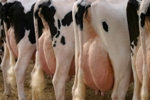Registration Open for NMPF Annual Meeting in Phoenix
September 09, 2013In a little more than two months, dairy farmers from around the country will gather at the Arizona Biltmore in Phoenix, AZ for the 2013 annual meeting that NMPF hosts jointly with the National Dairy Promotion and Research Board (NDB) and the United Dairy Industry Association (UDIA). The meeting will be held November 11 – 13.
The joint annual meeting offers attendees several days of informative programming, in addition to opportunities to interact and network with dairy producers and industry leaders from across the country. Dairy producers, cooperative staff, Young Cooperators (YCs), industry suppliers, trade press, and others from within the dairy sector are all invited to attend.
Individual and group meeting registration, along with hotel reservations, can be made online at www.dairyevents.com. Although online registration is preferred, a registration form may also be filled out and submitted via mail or fax. Online, mail, and fax registration must be submitted with payment by Thursday, October 17. Visit www.nmpf.org/nmpf-joint-annual-meeting for more information.
Trans-Pacific Partnership Negotiators Aim for 2013 Close
September 09, 2013Trans-Pacific Partnership (TPP) trade ministers met at the outset of the latest round of TPP trade negotiations in late August. The meeting was intended to help spur progress in the talks and move discussions closer to a goal of concluding by the end of this year.
The U.S. in particular has been increasingly vocal about the need for greater focus and progress to advance challenging issues at this stage. On two items in particular – market access talks with Canada & Japan – are at very early stages: August represented Japan’s first full TPP round of negotiations and Canada has to date continued to resist opening up its dairy market to any meaningful degree. NMPF remains closely involved in discussions with U.S. negotiators on all topics of interest to the dairy industry and has made the U.S. government well aware of the key deliverables needed in order to secure the industry’s support.
NMPF Stresses Need for Improved USTR Approach to Geographical Indications Issue
September 09, 2013NMPF has joined with the Consortium for Common Food Names (CCFN) and several other cooperatives, proprietary companies, and organizations to send a strong message to the U.S. Trade Representative (USTR) regarding the need for an improved approach to tackling the problem of escalating efforts by the European Union (EU) to monopolize the use of many common food names. For instance, in several U.S. free trade agreement (FTA) partners, the EU is on the brink of successfully restricting use of cheeses widely made in the U.S. such as parmesan, gorgonzola, and several others. NMPF and the letter’s other signatories stressed the importance of tackling this issue not solely as an Intellectual Property topic, but also as a de facto barrier to market access.
Through its membership in CCFN, NMPF has been actively supporting efforts to oppose these naming restrictions not only in our export markets, but also here at home. The launch of U.S.-EU FTA talks threatens to impose these name product limitations on our own domestic market, a concern of even greater proportion than the sizable export challenges we currently face.
New REAL® Seal Campaign Continues to Grow
September 09, 2013 NMPF continues to create awareness of dairy products – and the REAL Seal itself – through its new social media campaign connecting a new generation of consumers with products that use the Seal.
NMPF continues to create awareness of dairy products – and the REAL Seal itself – through its new social media campaign connecting a new generation of consumers with products that use the Seal.
To date, NMPF has made a significant initial investment to underwrite a variety of promotional activities, including a new website, a new Facebook page, blogger outreach, and a new animated character. This brief video highlights activities already underway, and those planned for the future.
Until last fall, the REAL® Seal website – www.realseal.com – was targeted only at companies using the REAL® Seal to help them learn what they needed to do to qualify for the program. Today, the website is focused on consumers of dairy products and foods with dairy as a significant ingredient. The REAL® Difference for Consumers section tells consumers how to differentiate REAL® dairy products and foods made with REAL® dairy ingredients from imitators. Another subsection provides nutrition information comparing the natural goodness of REAL® dairy products, to the fabricated nutrition of imitators.
In addition, a buyer’s guide will soon be added to the website. All companies using the REAL® Seal will receive a free basic listing, and the opportunity to expand their presence in the Buying Guide. Consumers interested in buying REAL® dairy products, or foods made with REAL® dairy ingredients, will be able to do so by using this Guide.
The REAL® Seal Facebook page — www.facebook.com/REALSealDairy — is reaching consumers, and more importantly, engaging them in why they should buy REAL® dairy products, and foods made with REAL® dairy ingredients. Since the Facebook page was launched in June, it has received nearly 60,000 “Likes.” This is the result, in part, of a paid advertising campaign initially funded by NMPF. The Facebook campaign has also benefited from the strong click-through rate, meaning consumers are continuing on to the REAL® Seal Facebook page rather than simply clicking “Like” on the REAL® Seal ad in their news feeds.
The program user fees being collected will go toward continuing these and other campaign elements, strengthening the connection between consumers and REAL® Seal users’ products. Future program elements will include a national blogger network, a Pinterest presence, email-driven direct marketing, and mobile apps.
USDA Quarterly Milk Production Reports to Resume in October
September 09, 2013 USDA’s National Agricultural Statistics Service (NASS) said last month that with the start of a new fiscal year on October 1, it will resume the quarterly milk production producer surveys it suspended earlier this year due to budget cuts.
USDA’s National Agricultural Statistics Service (NASS) said last month that with the start of a new fiscal year on October 1, it will resume the quarterly milk production producer surveys it suspended earlier this year due to budget cuts.
Back in April, NASS suspended its monthly milk production report because of the federal budget sequester. After NMPF protested the lack of government data, NASS agreed to continue providing a monthly production estimate, albeit produced without the use of farmer surveys to help verify milk output trends. Since April, the USDA has used data from federal milk marketing orders, dairy checkoff data, state departments of agriculture, and other administrative sources.
The producer survey program will resume with a late September mailing to dairy producers, and the release of resulting data on October 21. With the quarterly surveys, the dairy cow and milk per cow statistics will once again be available.
CWT Exports Top 150 Million Pounds
September 09, 2013The month of August was another solid month for the Cooperatives Working Together (CWT) Export Assistance program. Assistance was provided to member cooperatives on cheese totaling 10.820 million pounds and on butter (82% fat content) totaling 5.932 million pounds.
These sales bring the year-to-date total sales to 86.5 million pounds of cheese and 67.2 million pounds of butter. On a milkfat basis, that is the equivalent of 2.312 billion pounds of milk.
Exports of U.S. dairy products are up significantly this year and CWT has been a major contributor to the increase. Through June, CWT-assisted product shipments are 51% of total butter exports, 72% of total American cheese, and 18% of total cheese.
Farm Bill Tops List of Thorny Issues as Congress Returns
September 09, 2013 In a situation reminiscent of last year, Congress returns to Washington this week with a limited amount of time to deal with the farm bill before several current programs expire.
In a situation reminiscent of last year, Congress returns to Washington this week with a limited amount of time to deal with the farm bill before several current programs expire.
In 2012, the election season limited the amount of time Congress could deal with a new farm bill, and ultimately, a new measure wasn’t passed. This year, in addition to farm policy, lawmakers must also deal with the expiration of the fiscal year funding authority after Sept. 30th, extend the debt ceiling, and consider authorizing military action in Syria. These contentious items are expected to dominate action on Capitol Hill in September.
For those in agriculture hoping for action on the farm bill, the focus remains on the House, which passed a flawed, farm-programs-only measure in July as part of a two-step process. House leaders have talked recently in generalities about taking up the nutrition-policy-only title soon after reconvening on Monday. If that nutrition bill passes, the House presumably would name agriculture committee conferees to meet and hash out a final farm bill with counterparts from the Senate.
But the nutrition bill the House will consider is expected to cut $40 billion from food stamps, ten times the size of the reduction contained in the Senate farm bill. The extent of that reduction will not attract much, if any, support from House Democrats, and it will be a difficult figure to reconcile with the Senate’s version, once both measures reach the House-Senate conference committee process. If the two congressional chambers fail to agree on a farm bill that can be signed by President Obama by September 30, yet another extension of current programs is one potential outcome.
Another is that those programs that expire at the end of this month – including the Milk Income Loss Contract (MILC) program – will be left in limbo until a decision is made about whether to try for a new bill, or extend the current one – as was the case in the fall of 2012. Given where dairy prices are, no MILC payments are expected in the remaining four months of this year.
Other farm programs, including the dairy product price support program, are authorized through December 31. If either a new farm bill isn’t in place by then, or current programs aren’t extended yet again, the provisions of the Agricultural Acts of 1938 and 1949 will take effect, potentially resulting in much higher price support levels for a variety of commodities, including milk.
Dairy farmers should continue to urge lawmakers to pass a farm bill, including the dairy policy reforms endorsed by the Senate in June. The House gutted those reforms in July by approving margin insurance without a stabilization program to keep supplies from building up and prices from plummeting. Farmers can use NMPF’s Dairy GREAT system to send an email.





